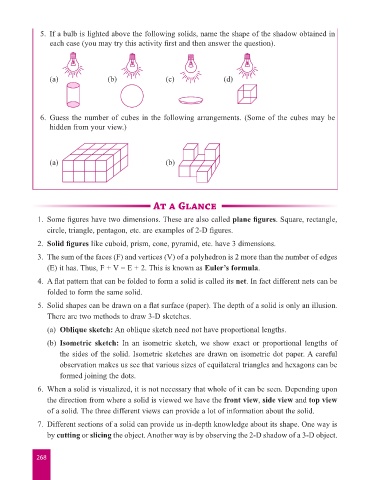Page 276 - Start Up Mathematics_7
P. 276
5. If a bulb is lighted above the following solids, name the shape of the shadow obtained in
each case (you may try this activity first and then answer the question).
(a) (b) (c) (d)
6. Guess the number of cubes in the following arrangements. (Some of the cubes may be
hidden from your view.)
(a) (b)
At a Glance
1. Some figures have two dimensions. These are also called plane figures. Square, rectangle,
circle, triangle, pentagon, etc. are examples of 2-D figures.
2. Solid figures like cuboid, prism, cone, pyramid, etc. have 3 dimensions.
3. The sum of the faces (F) and vertices (V) of a polyhedron is 2 more than the number of edges
(E) it has. Thus, F + V = E + 2. This is known as Euler’s formula.
4. A flat pattern that can be folded to form a solid is called its net. In fact different nets can be
folded to form the same solid.
5. Solid shapes can be drawn on a flat surface (paper). The depth of a solid is only an illusion.
There are two methods to draw 3-D sketches.
(a) Oblique sketch: An oblique sketch need not have proportional lengths.
(b) Isometric sketch: In an isometric sketch, we show exact or proportional lengths of
the sides of the solid. Isometric sketches are drawn on isometric dot paper. A careful
observation makes us see that various sizes of equilateral triangles and hexagons can be
formed joining the dots.
6. When a solid is visualized, it is not necessary that whole of it can be seen. Depending upon
the direction from where a solid is viewed we have the front view, side view and top view
of a solid. The three different views can provide a lot of information about the solid.
7. Different sections of a solid can provide us in-depth knowledge about its shape. One way is
by cutting or slicing the object. Another way is by observing the 2-D shadow of a 3-D object.
268

